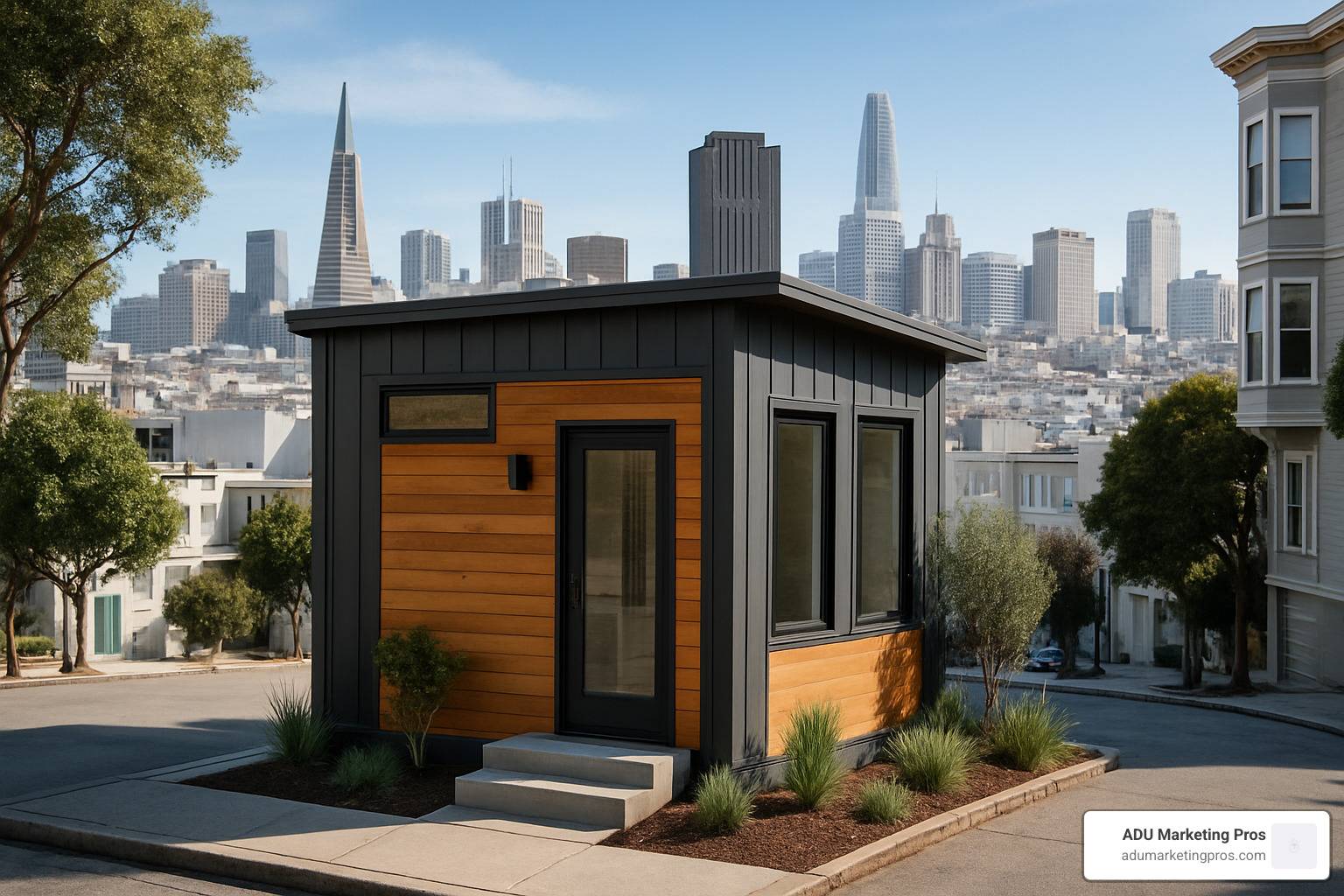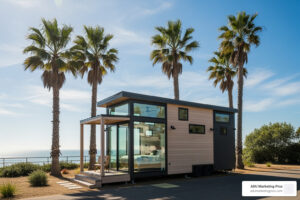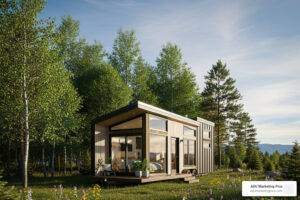The Growing Appeal of Tiny House San Francisco Living
Tiny house San Francisco opportunities are booming as the city grapples with a housing crisis that has nearly 8,000 people experiencing homelessness and skyrocketing rents. From the city’s newest Mission Cabins project with 60 tiny homes to private backyard ADUs scattered across the Bay Area, small-space living is becoming a serious solution to big housing problems.
Quick Guide to Tiny House Options in San Francisco:
- Public shelter villages: Mission Cabins (60 units), 33 Gough (70 units) for homeless residents
- Private tiny homes: $30,000-$175,000 for purchase, classified as RVs or ADUs
- Vacation rentals: Airbnb tiny homes throughout Bay Area starting around $100/night
- Legal requirements: Building permits needed for permanent placement, RV registration for mobile units
- Size limits: Typically under 400 sq ft, as small as 65 sq ft in shelter programs
The tiny house movement in San Francisco ranges from emergency homeless shelters like the $6.9 million Mission Cabins project to luxury tiny homes on wheels. The city’s unique geography, strict zoning laws, and progressive housing policies create both opportunities and challenges for tiny house development.

Tiny house San Francisco terminology:
– Custom ADU San Francisco
– Detached ADU San Francisco
– San Francisco ADU marketing
1. Tiny House San Francisco 101: Definitions & Types

Tiny house San Francisco living means different things to different people – and different city departments. Most people think of tiny homes as anything under 400 square feet, but San Francisco’s approach is more nuanced based on whether it has wheels, sits on a foundation, or serves a specific housing program.
Tiny Homes on Wheels (THOW) are mobile units typically under 400 square feet built on trailer chassis. These get classified as RVs by the state, requiring RV insurance and registration. The upside? You can relocate if your housing situation changes.
Foundation tiny homes are permanent structures built on fixed foundations, meeting State HCD standards and San Francisco Building Code requirements. More complex but more stable for long-term living.
ADU tiny homes are small secondary units emphasizing compact living while meeting ADU regulations. Popular with homeowners wanting rental income or family housing.
Shelter tiny homes like Mission Cabins pack essential living needs into just 65 square feet, proving even the smallest spaces can provide dignity and security.
The Bay Area offers models like the Bay Cottage and Tiny Victorian (212 square feet, $47,900-$49,900) and container builds like ABODE³ using shipping containers for 320 square feet of modern living space.

How the City Codes Define a Tiny house San Francisco
San Francisco doesn’t have a specific “tiny house” definition in its municipal code. Instead, municipal code §106A recognizes “efficiency dwellings” as small as 220 square feet for single occupants.
The California Residential Code requires at least one room of 120 square feet minimum, with additional rooms as small as 70 square feet. Ceiling heights must be at least 7 feet in most areas.
Is a Tiny house San Francisco the Same as an ADU?
ADUs (Accessory Dwelling Units) are secondary units built on properties with existing primary residences. A tiny house can be an ADU if it meets requirements, but not all tiny houses qualify.
The key difference is location and purpose. ADUs must be on lots with primary residences and follow ADU Modular Homes regulations. Tiny houses can be mobile units or standalone structures.
Backyard placement adds complexity. ADUs have specific setback requirements and must meet ADU Minimum Lot Size standards, while mobile tiny homes have different placement rules.
2. Legal & Zoning Maze: What You Need to Know
Getting your tiny house San Francisco project approved means navigating multiple city departments. You’ll need planning permits for permanent structures, building permits for construction, fire safety inspections, and compliance with Title 24 energy efficiency standards.
Tiny house on wheels routes require vehicle registration and understanding parking rules in residential zones. The recent SB 634 bill aims to streamline tiny home regulations, but San Francisco maintains strict safety code interpretation.
Understanding ADU Minimum Lot Size requirements is crucial for permanent installations in dense neighborhoods.
| Housing Type | Permits Required | Registration | Parking Requirements |
|---|---|---|---|
| THOW | Planning only | RV registration | Street parking rules apply |
| ADU Tiny Home | Planning + Building | Property tax assessment | Must provide 1 space |
| RV Classification | None for temporary | Vehicle registration | 72-hour parking limits |
Zoning for a Tiny house San Francisco: ADU vs THOW
San Francisco’s zoning districts treat tiny homes differently based on permanence. In RH-1 districts (single-family), you can build ADU tiny homes with permits, but THOWs are generally off-limits for permanent residence.
RH-2 districts offer more flexibility for both ADUs and temporary THOW placement. PDR zones open possibilities for tiny home villages with conditional use permits.
Remember: permanence changes everything. Living in a THOW full-time on private property likely violates zoning rules even if the structure meets requirements.
Fast-Track Options & Statewide Reforms
California’s AB 68 and SB 9 streamlined ADU approvals, cutting review times. City pilot programs offer expedited permitting for innovative housing solutions addressing the housing crisis.
Code enforcement waivers for emergency housing projects like Mission Cabins allow rapid deployment. Scientific research on interim housing success shows 48% transition rates to permanent housing versus 34% for traditional shelters.
3. Where to Find Tiny Homes & Communities Around the Bay

Tiny house San Francisco communities range from emergency housing villages to luxury vacation rentals. Mission Cabins opened in April 2024 with 60 units for homeless residents, while 33 Gough Street houses 94 people in 70 DignityMoves units. San Jose expanded with six sites hosting over 600 tiny home beds.
Private options include Sausalito houseboats, private backyard ADUs, and vacation rentals through Airbnb from Mill Valley’s eco-friendly designs to Livermore’s off-grid retreats.
Public-Run Villages Tackling Homelessness
Mission Cabins represents San Francisco’s most ambitious project with a $6.9 million budget creating 60 individual units prioritizing dignity and safety. Each resident gets lockable space with bed, storage, power outlets, and heating.
The 48% transition rate to permanent housing versus traditional shelters shows effectiveness. Ramon Contreras, who lived on streets for 10 years, told the SF Examiner that having his own space with a key changed his sense of security.
Case management services operate on-site with wellness checks every 30 minutes. The 33 Gough Street project achieved remarkable results: no one has turned down private room offers during outreach, compared to only 10% acceptance for congregate shelters.
Short-Term Stays & Try-Before-You-Buy Options
Airbnb tiny homes throughout the Bay Area let you test small-space living with nightly rates starting around $100. Some builders offer rent credit models where vacation costs apply toward purchase.
Off-grid retreats in places like Livermore feature solar power, composting toilets, and rainwater collection. The tourism draw spreads awareness through social media, normalizing compact living concepts.
4. Dollars & Sense: Costs, Financing, and ROI
Understanding tiny house costs requires separating structure cost from land, permits, and installation. While basic tiny homes cost $30,000, total investment often exceeds $175,000 including site preparation.
Cost Breakdown:
– Basic THOW: $30,000-$50,000 (Bay Cottage, Tiny Victorian)
– Premium tiny homes: $100,000-$170,000 (Resort 3/2 model)
– Site preparation: $10,000-$50,000
– Permits: $5,000-$25,000
– Land costs: Varies by location
Financing options include RV loans for certified THOWs, HELOC for property owners, personal loans, and green building grants. Understanding ADU Construction Cost factors helps compare options.
Budget Checklist for Your Tiny Home Journey
Pre-Construction Costs:
– Design and architectural fees: $2,000-$10,000
– Permits and approvals: $5,000-$25,000
– Site survey: $1,000-$5,000
Construction and Installation:
– Structure cost: $30,000-$170,000
– Site preparation: $10,000-$50,000
– Utility connections: $5,000-$25,000
– Transportation: $2,000-$10,000
Ongoing Expenses:
– Insurance: $500-$2,000 annually
– Utilities: $50-$200 monthly
– Maintenance: $1,000-$3,000 annually
A 20% contingency fund is essential for Bay Area permitting complexity.
5. Living Small: Amenities, Quality of Life, and Success Stories

Modern tiny house San Francisco spaces pack impressive functionality into compact footprints. Basic models include full kitchens with real appliances, loft bedrooms fitting queen beds, complete bathrooms, and smart home technology.
Luxury options feature solar power systems, outdoor decks doubling living space, and built-in storage solutions. Communities offer shared gardens, pet areas, and co-working spaces.
Day in the Life: Inside a Tiny house San Francisco
Ramon Contreras, first Mission Cabins resident after 10 years of homelessness, appreciates the lockable door, personal key, and privacy distinguishing his 65 sq ft unit from congregate shelters.
Private tiny home owners report energy bills under $50 monthly and find the minimalist mindset becomes a genuine lifestyle preference. The privacy factor – having your own lockable door and personal thermostat – transforms the affordable housing experience.
How Tiny Homes Stack Up Against Other Affordable Housing
Tiny homes typically cost $1,000-$3,000 monthly including utilities versus studio apartments at $2,500-$4,000 plus utilities. Compared to SROs, tiny homes offer similar square footage but often include private bathrooms and outdoor space.
Traditional ADUs offer more space, but tiny homes win on construction costs and flexibility. Both provide rental income opportunities, explaining increasing interest through our Local SEO San Francisco CA work.
Acceptance rates tell the story: no one has turned down private rooms at 33 Gough Street versus only 10% acceptance for congregate shelters.
6. The Road Ahead: Barriers, Innovations, and How to Get Involved

Tiny house San Francisco development faces significant barriers. Land scarcity remains the biggest challenge, with land preparation often exceeding structure costs. NIMBYism slows approvals despite housing crisis urgency. Financing gaps exist because traditional lenders struggle with tiny home classification.
Wildfire codes add complexity and cost, while utility connections don’t scale down proportionally with house size.
Despite barriers, exciting innovations emerge. Modular off-site construction improves quality while reducing on-site time. Relocatable designs offer flexibility when zoning or ownership changes. State funding for 1,200 units statewide represents major policy shift.
3D printing technology shows promise for reducing construction costs. Shared equity models help bridge the gap between rental and ownership.

For construction and architecture firms, the tiny home market presents significant opportunities. Bay Area regulation complexity creates strong demand for professional expertise navigating zoning, building codes, and utilities efficiently.
Success lies in understanding both technical requirements and human stories behind projects. Whether working on emergency homeless housing or luxury rentals, each project balances regulatory compliance with creating dignified, functional living spaces.
Tiny house San Francisco development depends on continued policy support, innovative financing, and builders working creatively within existing constraints. The movement has moved beyond experimental phase toward scaling real solutions.
Frequently Asked Questions about Tiny Houses in San Francisco
Do I need a building permit for a THOW on private land?
Yes, if you’re planning permanent residence. While tiny house San Francisco THOWs are classified as RVs, temporary stays under 30 days might not need permits. But using it as primary residence or rental requires ADU permitting process including site plans, utilities, and setback compliance.
The key distinction is permanence versus temporary use. Living full-time violates zoning laws without proper permits.
How much does it cost per month to live in a San Francisco tiny home?
Monthly costs vary dramatically. Emergency shelter residents pay nothing, while luxury rentals cost $400 nightly. Private THOW ownership runs $500-$1,500 monthly including utilities, insurance, and land rental. Utility costs stay low at $50-$200 monthly.
Rental costs for tiny ADUs typically run $1,500-$3,500 monthly. Land costs are the wild card – owning property dramatically reduces monthly expenses.
Can I legally rent out my backyard tiny house on Airbnb?
Maybe, but it’s complicated. San Francisco has strict short-term rental regulations. First, you need proper ADU permits for permanent structures. Then business licensing for rentals, host registration, and 90-day annual limits unless you live on-site.
Insurance becomes tricky – standard policies won’t cover commercial activities. The permitting process takes months and costs thousands. Long-term ADU rentals often make more financial sense with fewer regulatory headaches.
Conclusion
The tiny house San Francisco movement has evolved into a legitimate response to the city’s housing challenges. From Mission Cabins providing dignity to homeless residents to luxury vacation rentals, tiny homes prove that housing isn’t just about square footage – it’s about creating safe, comfortable spaces connected to community.
The regulatory complexity reflects San Francisco’s careful approach to housing innovation. While permitting can feel overwhelming and costs often exceed expectations, these requirements ensure safety and protect residents and property values.
For construction and architecture professionals, the tiny home market rewards expertise over generic approaches. Clients need guidance through zoning requirements, innovative compact design, and realistic project management accounting for San Francisco’s unique challenges.
The financial realities – from $30,000 basic structures to $175,000 installed units – show tiny homes aren’t automatically cheap housing. They’re efficient housing delivering value when planned thoughtfully. Understanding total project costs upfront enables informed budget decisions.
Looking ahead, housing policy convergence, environmental concerns, and technological innovation create genuine momentum. State funding for 1,200 units signals institutional support, while modular construction and off-grid system advances address practical barriers.
The most successful projects share common elements: realistic budgeting, expert professional guidance, and clear understanding of intended use. Whether developing emergency housing, creating rental income, or exploring alternative living, these fundamentals determine success.
Tiny homes succeed when solving real problems for real people. The movement’s future depends on delivering genuine value in a city where housing challenges affect everyone.
For more information about ADU-focused marketing solutions and how we help construction and architecture firms succeed in this specialized market, our team understands unique opportunities in the Bay Area’s evolving housing landscape.




